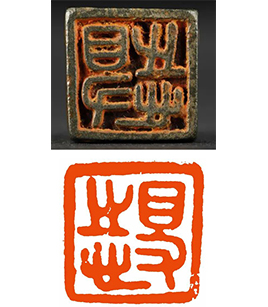Chinese seals

FILE PHOTO: A stone seal (above) and its impression (below) of the Warring States Period (770–476 BCE)
Dating back thousands of years, Chinese seals are more than just a unique motif: they are symbols of identity, status, and culture. A seal is used in lieu of signatures in personal documents, office paperwork, contracts, art, or any item requiring acknowledgement or authorship. Of Chinese origin, the art of seal engraving has spread beyond China and across East and Southeast Asia.
According to Cai Yunzhang, a research fellow from the Luoyang Municipal Institute of Archaeology, the earliest known example of stone seal in China was excavated in Henan Province and dated to over 8,000 years ago. During the Spring and Autumn Period (771–476 BCE), there was an increase in the quantity of Chinese seals paired together with textual references to them. Before the founding of the Qin Dynasty (221–207 BCE), all seals were known as xi. Qin Shi Huang, the first emperor of the Qin Dynasty, ordered that only the seals used by the emperor could be called xi. From then on, the seals used both by other government authorities and private individuals were generally known as yin.
With the development of seal making, the discipline gradually separated from the general art of printing and craftsmanship, and was incorporated into the unified art of calligraphy and seal engraving. Various seal engraving styles reflect the evolution of the Chinese scripts through different periods. For instance, during the Zhou Dynasty, mainly the scripts of dazhuan [large seal] or bronze inscriptions were used. Today, seals continue to be commonly used in official documents and for private occasions, and seal engraving remains a fine art in China.

 PRINT
PRINT CLOSE
CLOSE